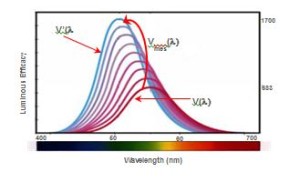Based on CIE 191:2010 – Recommended System for Mesopic Photometry Based on Visual Performance, mesopic vision actually lies in between the scotopic and photopic vision. The human eye has two types of photoreceptors called rods and cones. The cones are maximally active with adaptation luminances larger than about 5 cd/m2 (known as the photopic vision). The spectral sensitivity of photopic vision is characterised by the V(λ curve and reaches its maximum sensitivity (683 lm/W) at around 555nm. At adaptation luminances lower than about 0.005 cd/m2, only the rods are active (known as the scotopic vision). The spectral sensitivity of scotopic vision is characterised by the V’(λ curve. It reaches its maximum sensitivity (1700 lm/W) at around 507nm. At adaptation luminance level between 0.005 cd/m2 to 5 cd/m2, both the rods and cones are active (known as the mesopic vision). From high to low luminance levels, the activity of rods becomes more important. The overall spectral sensitivity Vmes(λ gradually shifts into the direction of shorter wavelength (i.e., blue region). Hence, instead of one spectral sensitivity function, several functions are needed depending on the light level throughout the mesopic region, as shown below.

The mesopic luminance region covers a wide range of lighting applications, such as road and residential area lightings, where we have relatively low lighting levels. Conventionally, such public lighting measurements are made based on human’s photopic response, V(λ. These photopic measurements favour “warmer” light (i.e., yellowish white light). On the other hand, scotopic measurements favour “cooler” light (i.e., bluish white light). Hence, artificial light sources that are tuned to how human see under mesopic lighting conditions can be used to reduce lighting levels and, hence the power consumption, while providing the same or even better visibility.
To calculate mesopic luminance with the CIE mesopic model, the following parameters are required:
1. Background photopic luminance (i.e. adaptation luminance)
2. S/P Ratio
S/P Ratio
The S/P ratio is the ratio between the scotopic and photopic value frequently used by lamp manufacturers. Due to the shift in eye sensitivity a difference in luminance/illuminance value will be measured under low luminance conditions. The S/P ratio is a simple to use index that enables the user to quantify the luminance perception of a light source under scotopic conditions.
Konica Minolta Luminance Meter LS-100 or LS-110 is commonly used for photopic luminance measurement in public lighting performance measurement. Illuminance Spectrophotometer CL-500A and Spectroradiometer CS-2000 series (with Data Management Software CS-S10W) are both capable of S/P ratio measurement. Click here for more information on lighting technologies, principles and measurement.
